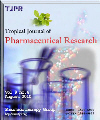
|
Tropical Journal of Pharmaceutical Research
Pharmacotherapy Group, Faculty of Pharmacy, University of Benin, Benin City, Nigeria
ISSN: 1596-5996
EISSN: 1596-5996
Vol. 14, No. 8, 2015, pp. 1349-1355
|
 Bioline Code: pr15177
Bioline Code: pr15177
Full paper language: English
Document type: Research Article
Document available free of charge
|
|
|
Tropical Journal of Pharmaceutical Research, Vol. 14, No. 8, 2015, pp. 1349-1355
| en |
Anti-Oxidative, Metal Chelating and Radical Scavenging Effects of Protein Hydrolysates from Blue-spotted Stingray
Chai, Tsun-Thai; Tong, Shi-Ruo; Law, Yew-Chye; Ismail, Nor Ismaliza Mohd; Manan, Fazilah Abd & Wong, Fai-Chu
Abstract
Purpose:
To evaluate protein hydrolysates and membrane ultrafiltration fractions of blue-spotted
stingray for metal chelating and radical scavenging activities, as well as protection against oxidative
protein damage.
Methods:
Stingray protein isolates were hydrolysed with alcalase, papain and trypsin for 3 h. Alcalase
hydrolysate was fractionated by membrane ultrafiltration to yield < 3, 3 - 10 and > 10 kDa fractions.
Peptide contents, iron and copper chelating activity, 2, 2'-azino-bis(3-ethylbenzothiazoline-6-sulphonic
acid) (ABTS) and hydroxyl radical scavenging activities, and protection against oxidative protein
damage were evaluated.
Results:
Three-hour alcalase hydrolysate (3AH) had the highest peptide content and the lowest half
maximal effective concentration (EC50) for ABTS radical scavenging (793.9 μg/mL), hydroxyl radical
scavenging (6.93 mg/mL), iron chelating (116.4 μg/mL) and copper chelating activity (2136.9 μg/mL)
among the hydrolysates. Among the fractions of 3AH, < 3 kDa fraction had the best iron chelating
activity, 3 - 10 kDa fraction exhibited the highest ABTS radical scavenging activity, while > 10 kDa
fraction showed the best copper chelating activity. The < 3 kDa and 3 - 10 kDa fractions had similar
levels of hydroxyl radical scavenging activity to reduced glutathione. The protective effects of 3AH and <
3 kDa fraction against oxidative protein damage were comparable to that of reduced glutathione.
Conclusion:
Alcalase is the best protease for producing hydrolysates with metal chelating and
antioxidant activities from stingray proteins. Alcalase hydrolysate, specifically its < 3 kDa fraction, has
potential for future applications in antioxidant therapy and health food formulation.
Keywords
Dasyatis kuhlii; Membrane ultrafiltration; Protein hydrolysate; Glutathione; Peptide content; Metal chelating; Radical scavenging
|
| |
© Copyright 2015 - Tropical Journal of Pharmaceutical Research
Alternative site location: http://www.tjpr.org
|
|
